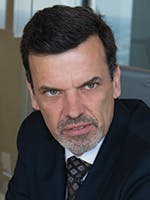Intervale waiting to invest
IN OFS, FIRM SAYS IT PREFERS TO INVEST LATE IN THE DOWNTURN - AND WE'RE NOT THERE YET
PHOTOS BY SYLVESTER GARZA
EDITOR'S NOTE: Charles Cherington, managing partner of Intervale Capital, co-founded the firm in 2006 after managing two smaller private equity firms that focused on buyouts in the energy, transportation, and manufacturing sectors. He has more than 22 years of PE experience. Cherington has an MBA, with honors, from the University of Chicago and a BA from Wesleyan University. We also spoke with Will McMullen, founder and managing partner of Bayou City Energy, which focuses on capital solutions for small upstream operators. He has a bachelor's degree, with honors, from Harvard.
OIL & GAS FINANCIAL JOURNAL: Intervale Capital focuses on the oilfield services market. Can you tell our readers more about your firm and why you chose to focus on this sector?
CHARLES CHERINGTON: Sure. Intervale Capital has raised $1.3 billion in three funds that are invested in the oilfield service space. That can extend from upstream - that is, helping the E&P operators drill, complete, and produce their wells - all the way into the midstream space with pipelines, processing, etc. That's sort of our bailiwick. We are committed to keeping fund sizes to $500 million or smaller. Fund III is $496 million. We are heavily focused on doing one thing well, with a better level of expertise. We believe that's the best way to invest. I have been in that arena with Intervale since 2006, and although I started as a generalist, I've been investing in the oilfield exclusively for about 13 years. We originally opened shop in Boston, but over time we shifted the firm's resources to Houston, because that is where the industry is, and we felt we needed to be here. Although we still maintain a satellite office in Boston, our 12 investment professionals are much more effective in what they do being in Houston full time.
OGFJ: Obviously the industry is in a down period, and the oilfield services sector has been one of the hardest-hit industry sectors. Do you see any bright spots?
CHERINGTON: No. I believe the industry in North America is in slow liquidation, and that's the case across the board. At these prices, the industry is not sustainable in the long run. We see a lot of consolidation, bankruptcies, etc. just starting. We expect this will be much more significant in 2016 than it was in 2015. There is no guarantee the downturn will end this year or even next. It could go on for several years. At these prices, people can drill wells and perhaps make money on incremental wells. They can produce profitably out of existing acreage in very rare instances - probably just the core areas in a couple of basins in the US. Otherwise, you're looking at people who are slowly liquidating their businesses - and it will be that way for some time to come.
OGFJ: It has been reported that there were more than 50 bankruptcies in the upstream sector in 2015. That is about one a week.
CHERINGTON: It will be higher in 2016 - much, much higher in both services and E&P. We just got out of a meeting with one of our senior lenders, and they are preparing for a year that's probably as bad as anything they've seen since the 1980s.
You have a supply and demand imbalance, and the only way supply can respond in the short run is for prices to decline so low that you shut in existing production. And that means - pick a number, perhaps $5 a barrel - a number much lower than where we're at right now at around $30. What that would do is kill future production. So what we're doing is causing real damage to the industry's ability to meet demand five years from now. Nothing we are doing today is helping to immediately alleviate the supply and demand imbalance, and it's unlikely that prices will drop to the level that we'll see significant shut-in production, because companies need to keep producing oil in order to fund operations and service their debt.
On the other hand, the longer this goes on, the more acute the future shortage will be. Right now, it's hard to imagine a shortage, but five years from today or whatever the time is, we're going to face major challenges as a global industry to meet demand because of the dramatic cut in capex for long-term projects. More than $250 billion in projects have been permanently cut or delayed indefinitely, and that number is increasing every day. The market's attempt to fix what is happening today isn't really working in the current period, and it's setting up an overshoot in the future.
"I believe the industry in North America is in slow liquidation, and that's across the board. At these prices, the industry is not sustainable in the long run. We see a lot of consolidation, bankruptcies, etc. just starting. We expect this will be much more significant in 2016 than it was in 2015. There is no guarantee the downturn will end this year or next. It could go on for several years." - Charles Cherington
OGFJ: What you are saying seems to reinforce the view that the boom and bust cycles in the industry will continue and that maybe five years or so from now we'll see demand exceed supply to the extent that prices could spike again. Is that correct?
CHERINGTON: Yes, they will. There will be a boom, and everything will repeat itself as it does over and over again. It's hard to imagine the industry ever being able to regulate that. That is part of what we at Intervale are being paid to manage through. There will be a lot of opportunities for the service sector to buy companies at great valuations. There is still a huge bid-ask spread today, and companies are often going into bankruptcy rather than selling at prices that make sense. That will probably start to change toward the end of this year. In our view, in the service space, you want to be investing in the very late innings of the downturn. We're not there yet.
In the E&P space, it's very different. For our friends at Bayou City Energy, they are already seeing spectacular conditions from a buying perspective. The reason is they're buying a set of assets, as opposed to Intervale where we would be buying or selling a stream of future cashflows, and when those expected cashflows are negative, there is really nothing to buy or sell. So, a very different dynamic in those two markets, depending on where you are in the cycle.
OGFJ: Are some market segments within the oilfield services sector doing better than others?
CHERINGTON: Certainly production will be better than anything else because production is more of an annuity than drilling and completions. You can have a spectacular drop in rig count, but as long as wells are producing, they require chemicals, they require artificial lift, they require infrastructure maintenance, etc. So everybody likes production. What's different about this downturn is we're seeing pricing pressure on some of the production spheres that hasn't been seen in 30 or so years. This is such an acute and far-reaching downturn that even the production space has been affected. The activity level is holding up, but there is pressure to reduce prices.
You know, completions are where the money is spent to get a well online. Completions are about high volume, highly efficient manufacturing where you're doing multiple stages in a horizontal well and you want to find technology or techniques that either reduce the cost of each stage or increase production. If you can do that, you can capture market share even in a down market. But that share capture is very rarely going to offset the spectacular decline we've seen in activity and pricing. But we are still drawn to differentiated completion product and service companies where we think that potential to capture market share is very high.
The other point is that, from a geography perspective, if you're offshore in the deepwater, that tends to be such a slow-moving ship that even in this kind of price environment, the activity has stayed pretty consistent. International markets also tend to be much less susceptible to declines in activity and the low-price environment. As a result, we will focus on production and completions from a product and service perspective, and we want to focus on deepwater international wherever possible.
To put a fine point on it, North American land has just gotten annihilated. You've got to be a really special company today to generate profits onshore in North America.
OGFJ: Which shale plays are the best performers?
CHERINGTON: Well, the Bakken has been hit the hardest. The places that are holding up best are some core acreage in the Permian and the Eagle Ford, and there are a few areas in Oklahoma that are attractive right now. Outside of those, there has just been a massive reduction in rig count across the board, but the activity levels in those three pockets tend to be better than other areas of the country.
Gas markets seem to be challenged in an almost structural way. If you look at the Northeast where the Marcellus has been a spectacular success, there has been a huge decline in activity there as well. Whereas we think we'll see a recovery in oil prices in the next five years, it's conceivable that natural gas is facing a perpetually depressed market, given the deliverability of supply in the Northeast.
For service companies, they are really focused on the Permian Basin, which by the way is probably a more attractive basin than the next three combined because of its size and the fact that there are so many different pay zones to pursue. So the Permian will grow in importance, but there will be selective spots in the Eagle Ford and in Oklahoma that will grow as well. North Dakota will persist, but it will be a much smaller market. Until prices recover, that will be the case.
OGFJ: Will, tell our readers a little about Bayou City Energy. You founded the company in 2015 amid an industry downturn, and you focus on small upstream operators. Isn't that a pretty competitive industry segment? What differentiates Bayou City from other private equity firms?
WILL MCMULLEN: You're exactly right. E&P private equity is a competitive space, so what we like to do is go in and find economic systems and niches within the E&P complex where upstream private equity capital can be more competitive against other capital sources. We find that our capital can be most helpful to smaller operators, given the relatively large number of players and lack of institutional equity focus on them. We define "small" as operators with a capitalization of less than $50 million. We want to be able to write equity checks as low as $5 million and as high as $35 million per investment, and we can go higher with co-investment from our limited partner pool.
What really differentiates us is our narrow focus on small operators. In order to focus on this sliver of the E&P complex, we have to deliberately not participate in other mediums of the upstream. You're not going to see us buying royalties, we're not buying minerals. We want to partner with operators who drill their own wells, control HBP acreage and own lots of proved developed reserves. Another thing that makes us a bit unique is that we're not afraid to be in the conventional basins. We're looking for opportunities for AFEs (authority for expenditures) on a per well basis of less than $1 million.
We also will opportunistically participate in off-balance sheet drilling joint ventures. We do this because it affords our drilling capital another medium to find its way into the best locations in North America. A recent example is our joint development announcement with Alta Mesa Holdings to drill 40 wells in the STACK play of Oklahoma. This agreement is a prime example of our flexible E&P investment platform whereas we can allocate capital to target the best drilling locations available today while preserving the inherent option value in buying into HBP acreage alongside small operators.
As the downturn began to kick in last year, many operators began divesting some of their non-core assets. But as we enter into 2016 when hedges start rolling off and bank decks collapse, operators that couldn't get their heads around a widening bid-ask spread are going to be forced to sell their crown-jewel assets. Without exaggeration, I believe 2016 will provide generational buying opportunities for companies like Bayou City Energy. We're looking to put some dollars to work over the next couple of years.
OGFJ: Are you focused more on liquids-rich assets or gassy assets?
MCMULLEN: We're opportunity-driven, so we don't really have a bias toward either commodity, but as Charles says, there are some structural problems inhibiting gas ever getting back above the $4 level. We want to partner with great people who have done it before, and it's a bonus if they have worked with private equity providers previously. We want to buy producing assets with heavy PDP components to their reserve profile, and because of that we're really asset-focused first. When we go through our screening criteria, we're looking for the lowest break-even F&Ds out there, both from a new-drill standpoint as well as what I call operational F&D, which is: Where can we operate at the lowest break-even on a dollar-per-barrel basis?
OGFJ: Are you focused on certain specific regions?
MCMULLEN: We're North America focused. At $30 oil, the geographic footprint that makes sense to drill wells or exploit existing production is a lot smaller than it is at $80 or $100 oil. In our view, there are only a handful of counties where it makes sense to exploit hydrocarbons right now, and we're focused on those counties. As operators become more efficient in their ability to squeeze pennies out of vendors on Charles' side of the table, we're going to be very deliberate in how we are high-grading our pipeline and where we are targeting geographically.
OGFJ: Can I get each of you to explain how you are working together?
CHERINGTON: We've been looking for the right E&P investment team to partner with for a long time - there just aren't that many that focus on smaller operators. Many of the teams have cut their teeth on much larger funds, and therefore may not have the focus or background for the small end of the market. Although it's a big, competitive industry, there are only a handful filling this market niche. We think there is a lot of value to be extracted at the small end of the market. To make a long story short, our investors really wanted to see this happen, it has just been a case of finding the right team to partner with. Finally, across our three funds, we have 12 platform companies that provide products and services to E&P operators, so we see the E&P dealflow and there are a lot of opportunities for collaboration between operators and service companies. A good example is our Intervale portfolio company Aegis Chemical Solutions is providing production chemicals to Bayou City portfolio company TXON-SCZ. Aegis' treatment program is generating cost savings for TXON-SCZ of 10-20% while increasing production by 5-10%. When you think about it, many of the customers our service companies have are potential targets for Will and his fund. And these management teams can benefit from the expertise of our portfolio companies. So it's beneficial to both sides.
MCMULLEN: Just to expand on that a bit, our E&P portfolio companies are smaller operators that tend to compete very well against bigger ones from a technical perspective. But where they often compete less well is knowing how to most efficiently bring those hydrocarbons to the surface. Having a direct line of communication to a portfolio of service companies that can consult with us on any aspect that we are embarking upon is a unique competitive advantage for our portfolio companies at Bayou City. A good example of that is when former Intervale portfolio company CEO and Bayou City Advisory Board member Don Gawick introduced White Knight Production, one of our E&P portfolio companies, to some of his service teams out in California. Through those conversations, White Knight adopted the gravel pack completion technique in their fields and have realized significant production uplifts in doing so. There are more examples of these type of successful partnerships, and we expect to exploit more opportunities going forward.
OGFJ: As investors, do you both take a hands-on approach with your portfolio companies? How involved are you with those companies? You both seem to be more active than passive investors.
CHERINGTON: Will and I share a philosophy of being hands-on. When the game plan is in place, an experienced management team should be good enough to be able to perform on their own, but the first year can be intensive. We are there to help. It's amazing how much work there is to be done just to bring some of these fields up to 21st century standards. The management teams are good at doing some of that, but we are able to tap into experts that they may not know with specific expertise in artificial lift, production chemicals, state-of-the-art completion techniques, etc. That's a huge advantage. We are also there to set strategy, go over the budget, implement best practices - all those things you want to see an active board do.w
OGFJ: On the oilfield services side, what are some of the things you can do during a downturn to make the company more efficient, reduce costs, etc.?
CHERINGTON: Look, the rig count is down over 65%. Pricing on average is down about 30%. That is a loss of 65% of your business along with a 30% reduction in pricing. It's just an absolutely brutal market right now. One thing we do is make sure we're prepared before we go into a downturn by making sure we don't have too much debt. We have to be prudent with our capital structure, much more than you would be if you were in a generalist market. We shy away from mezzanine debt, we try to limit our senior debt, and try to make sure we have adequate cash reserves to fund all of our companies. That's the first thing because if you overpay and overlever, there is no way out in this kind of market.
Secondly, when you see the storm clouds gathering, you have to start cutting swiftly and deeply. It's a horrible, painful thing to do, but you have to be unsentimental about it. If you're not, you're going to lose the whole patient.
We have a very good group of senior managers running these businesses. In many cases, they're on it before we even pick up the phone. In other cases, we might have to be a little more proactive with them. As this downturn has unfolded, we've been through five sets of cost reductions with several of our companies. There will be more this year as conditions continue to deteriorate. The idea is to have companies consume as little capital as possible during a downturn. You have to cut so that you are generating cashflow even if the size of the business is dramatically reduced because if you don't do that you simply won't have the capital reserves or the staying power to survive.
The other thing you want to look at is whether each geographic location on a variable cost basis is carrying its own weight. If it's not, you have to take a very hard look at whether it's worthwhile to subsidize because the option value on the backside may take many years to realize. So, it's important to aggressively work with cut costs, maintain prudent balance sheets, and work with management teams to respond swiftly and severely as difficult times require.
OGFJ: Thank you for your time today, and good luck to you both.




